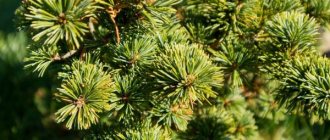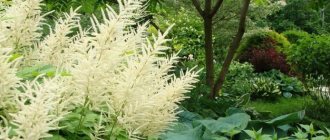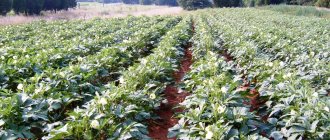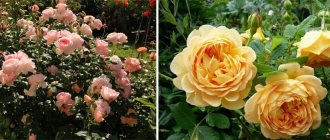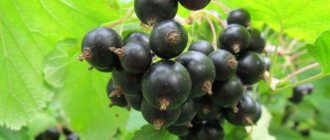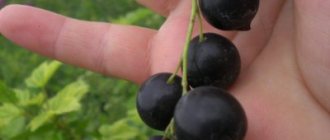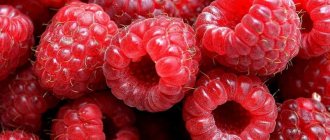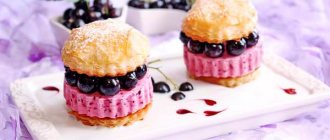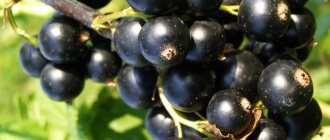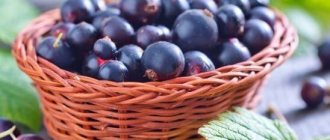Yadrenaya currant got its name for a reason - it is one of the largest-fruited varieties in Russia. Its berries reach 2 cm in diameter and have a rich currant aroma. Let's find out how to plant this variety, what is remarkable about it, and what are the features of its cultivation?
Currant variety “Vigorous”
with proper care, you can remove up to six kilograms of berries from each “Yadrenaya” currant bush
The main advantage of the “Yadrenaya” variety is its large fruits, which is why they are often mistaken for grapes
History of the appearance of the variety
Yadrenaya currant was bred at the end of the 20th century at the Siberian Horticulture Research Institute. It immediately created a sensation among gardeners - its berries were larger in size than the vast majority of varieties. And even now Yadrenaya is one of the largest-fruited versions of black currant.
A hybrid with giant berries was obtained by cross-pollination of different varieties of currants. To work on the new variety, breeders used “Altai’s Favorite”, “Dikovinka” and “Bredthorp”. The variety has been on the State Register since 2000. Recommended for Western Siberia and the Volga-Vyatka region.
Description of vigorous currant
Brief botanical description:
- Bush. Compact, medium spreading, weakly leafy. It grows in height and width up to 1.5 m. The crown is not dense. The shoots are erect, of medium thickness, green with blush and slight pubescence.
- Leaves. Dark green, five-lobed, wrinkled and vesicular. The veins are pinkish in color, pressed into the surface of the plates. Along the edges of the leaves there are sharp, slightly curved teeth with creamy points.
- Fruit. Large, black, shiny, regular spherical shape. The skin is dense and fleshy. They grow on clusters of 6-12 pieces. The fruit contains many seeds - they are large but soft.
- Flowers. Small, white-pink, with a pleasant sweet aroma. 4-10 pieces are formed on the stalks.
The size of Yadrenaya currant berries is comparable to a five-ruble coin; due to its large size, it is often confused with grapes.
Description of the variety
Currant bushes of the Yadrenaya variety are characterized by restrained growth.
Comment! The plants do not spread much to the sides and have a sparse bush shape, which allows the berries to be well illuminated by the sun.
They reach a height of only 1.5 meters.
Young growing shoots have an average thickness, although they can grow quite thick. The color of the bark is standard green, with a faint anthocyanin blush appearing here and there. The pubescence is weak.
Lignified adult currant shoots differ from young ones mainly in the color of the bark - from light to dark brown.
The buds are medium-sized, apical, deviated, collected in groups of 1-3 in each node. Their shape is ovoid with a pointed tip. The color is bright red, the pubescence is weak.
The leaves have a standard five-lobed shape, are shiny, leathery, dark green, slightly wrinkled and vesicular. There is no pubescence on the leaves, the veins are deeply depressed. The main veins have a dark pink tint. The teeth are wide, of medium length, and curved. Cream dots are clearly visible on them. The leaf petioles are medium in length and thickness, pink in color, and have slight pubescence.
The flowers are medium-sized, pale pink. The brushes are elongated in length so that they contain from 6 to 12 loosely closed berries.
The stalks are thick, long, pubescent, and hold clusters of berries well on the bushes.
Black currant Yadrenaya is a late-ripening variety in terms of ripening time. Its berries begin to ripen only towards the end of July, and in some regions even in August. Fruiting occurs in a fairly short time, which is especially beneficial for farmers for industrial cultivation.
The variety shows good resistance to both frosty winters (it can tolerate down to -30°C without shelter, and with good snow cover - up to -40°C), as well as extreme heat and drought, which makes it suitable for cultivation in many regions.
Attention! Yadrenaya currant is self-fertile - it does not require additional pollinators for normal fruiting, although, as a rule, several varieties of currant grow in any garden.
The early fruitfulness of this currant also deserves attention - already in the first year after planting it can bear a harvest, but the branches of the 2nd and 3rd year of fruiting are the most abundant in terms of the number of fruits.
The yield of the Yadrenaya currant variety deserves admiration - up to 5-6 kg of berries can be harvested from one bush. When grown on an industrial scale, this figure varies between 6 to 12 tons of berries per hectare and depends on agricultural technology, planting density and plant age.
Currant variety Yadrenaya is also characterized by good resistance to powdery mildew and bud mite. True, susceptibility to anthracnose is only about 3 points.
Characteristics of berries
The black currant berries of the Yadrenaya variety break all records in size and are considered practically the largest, if we consider the varieties of domestic selection as a comparison.
- The shape of the berries is round, sometimes slightly oblong, as if plum-shaped.
- The berry sizes reach 2 cm in length and 1.5 cm in width. Many people confuse the berries of this currant with grapes or cherries.
- The weight of one berry can reach up to 8 g, the average weight is 5-7 grams. Usually the berries are well balanced in size and weight.
- The flesh is fleshy, the skin is thin but durable. The berries contain a significant amount of fairly large seeds.
- The color of the fruit is black, without intense gloss.
- After being torn off, the berries do not leak juice, and after picking with brushes they may not fall off for a long time.
- Currant berries of this variety have an amazing aroma and sweet and sour taste. According to tasters, the taste quality is rated at 4.3 points. Many people consider the taste of Yadrenaya berries to be downright sour, but if you have the opportunity to let them hang on the bushes after ripening, do so. And you will be able to appreciate their taste.
- The berries contain: sugars – 9%, ascorbic acid – 96 mg/100g, dry soluble substances – 8-11%, titratable acidity – 3.7%.
- The use of berries is universal. It is best to freeze them for the winter or grind them with sugar to preserve all the vitamins. But they will also look luxurious in various compotes, jellies, preserves, jams, etc.
- The transportability of the berries is low. It is better to transport them only short distances.
Characteristic qualities
The variety blooms in mid-spring and bears fruit in mid-summer. The variety is considered self-pollinating, but it is recommended to plant it close to other blackcurrant varieties.
Main characteristics of Yadrenaya currant:
| Parameters/characteristics | Meaning/Description |
| Ripening period | mid-late (ripening – mid-July) |
| Productivity | 4-6 kg per bush, from 1 ha – 6-12 t |
| Frost resistance | high |
| Drought resistance | high |
| Disease resistance | resistant to hazel grouse, bud mite and powdery mildew |
| Fruit weight | 5-6 g |
| Taste of fruits | balanced sweet and sour |
| Transportability and keeping quality | unsatisfactory |
| Duration of fruiting | 6-7 years |
| Fruiting | for 2-3 years of disembarkation |
Other features of the variety:
- The growth rate of shoots is average.
- The berries are easily separated from the stalk. The skin is not damaged when the fruit is torn off.
- About 600 berries ripen on one branch.
- Ripe berries can be kept on the bush for 3-5 days - they will become sweeter.
The taste and quantity of Yadrenaya fruits are affected by cross-pollination. This is probably why the taste reviews range from "excellent" to "mediocre". In numerical terms, this is shown by tasting scores of the fruit - from 3.8 to 5.
An overview of the Vigorous currant variety is presented in the following video:
Black currant Yadrenaya: planting and growing
Experts recommend planting black currants of the Yadrenaya variety in the autumn - about a month before the onset of cold weather. When planted in the spring, the bushes take a long time to adapt to a new place and get sick.
It is best to purchase annual Yadrenaya currant seedlings for planting, which have grown at least 3 shoots and have a well-branched root system.
Important!
Before planting, do not put any fertilizers in the holes, as they can burn the tender currant roots.
But when planting Yadrenaya currants in the fall, in the spring, humus or compost (at the rate of 5 kg per square area) should be added to the area where it is planned to plant this shrub for digging.
The planting scheme for Yadrenaya currants is as follows:
the distance between planting holes in a row should be at least 1 m, and the row spacing should be at least 1.8-2.0 m.
The seedlings are placed in the center of the dug holes, the roots are straightened, covered with nutrient substrate and watered abundantly. After planting, the shoots are shortened, leaving no more than 3 buds on each.
Author's addition:
Black currant Yadrenaya is not afraid of frost, but still, planting varieties of different fruiting periods on the site will reduce the risk of a decrease in yield for various reasons, depending on weather conditions. The bushes are planted at a distance of 1 m from each other so that all bushes are evenly illuminated by the sun and do not compete with each other for nutrients in the soil. Currants do not like acidic soil, and it must be corrected by liming.
Planting currants - video
Advantages and disadvantages
Advantages:
- Precociousness. Already in the second year after planting, large black berries appear on the bush.
- High yield. Mature bushes produce up to 6 kg of berries.
- High winter hardiness. The bushes can easily survive frosts of 30 degrees and even higher.
- Resistance to currant diseases. The variety is resistant to the most ubiquitous fungal disease of berry crops - powdery mildew.
- Large fruit. Some specimens reach 8-9 g. Usually the fruits on one bush grow to the same size.
Disadvantages of the variety:
- During transportation, the berries quickly lose their presentation.
- Demanding about feeding and pruning.
- The lifespan is shorter than other varieties. After 6-7 years, the bushes have to be uprooted and replaced with new ones.
- Many gardeners are unhappy with excessive sourness. This is explained by the increased content of vitamin C in Yadrenaya fruits - there is almost twice as much of it as in other varieties (95 mg per 100 g of fruit).
Planting currants
The variety is demanding on growing conditions – soil quality and lighting. If you choose a site poorly, or plant unhealthy planting material, you can’t count on a good harvest.
You will learn about the features of planting black currants from this article.
Selection of seedlings
Two-year-old seedlings take root best. Signs by which healthy planting material is determined:
- 2-3 strong shoots - fresh, undamaged, without signs of lethargy;
- absence of spots or plaque on the leaves - they indicate the presence of fungal and other diseases;
- the color of the bark is light brown, the leaves are green, rich;
- the root system should have 2-3 separate roots 25-30 cm long, the color of the roots is dark brown, without defects.
Seedlings are sold in pots - with closed roots, or with an open root system. The first option is more convenient; the seedling does not receive stress during transplantation, since the roots fall into the planting hole along with a lump of earth.
Choosing a place and time
How to choose a place to plant Yadrenaya:
- Well lit area. A little partial shade is allowed.
- It is desirable that there is protection on the north side - for example, a wall or fence.
- The maximum permissible groundwater level is 1 m.
- Lowlands where water stagnates are not suitable.
- Soils need to be light, with good breathability. The most suitable soils are podzolic, gray earth and sandy loam soils.
- The plant prefers slightly acidic soils.
- When planting, it is important to take into account the proximity of neighboring plants - the bush will grow taller and wider over time. It is not recommended to plant currants near trees and tall bushes.
- The best predecessors are vegetable and ornamental crops. Undesirable ones are currants and gooseberries. If these berry crops grew nearby, the planting is moved 1 m to the side.
Yadrenaya can be planted in the spring, when the threat of frost has passed, or in the fall - 2-3 weeks before the onset of persistent cold weather. For regions in which the variety is zoned, spring planting dates are the first ten days of May, and autumn planting dates are mid-September.
Soil preparation
Preparing the soil for planting:
- Find out what the acidity of the soil is. If it is high, add wood ash or dolomite flour to the soil - 500-250 mg per 1 sq. m. m respectively.
- If groundwater comes close to the surface, fill a half-meter hill and make effective drainage. To do this, add river sand, small ceramic shards and brick chips to the bottom of the planting hole. The thickness of the drainage layer should be at least 5-7 cm.
- Weed and dig up the place where the currants will be planted, removing debris, stones and weed rhizomes.
- Dig a hole approximately 50cm deep and wide. You should dig and prepare the hole two weeks before planting. The depth of the hole depends on the fertility of the soil; the lower it is, the deeper you need to dig, and the more humus will be required.
- Fill the hole with soil mixture. Prepare it from the fertile layer - this is the top 15-20 cm of soil, and fertilizers. For one pit, take 15 liters of humus or rotted manure, 100 g of superphosphate, 35 g of potassium nitrate. Or use a chemical fertilizer that contains potassium and phosphorus - for example, nitrophoska. Fresh manure should not be added to the planting hole.
- Pour the resulting soil mixture into the hole to form a hill. Cover the hole with waterproof material. After two weeks, weather permitting, you can begin planting.
If planting is done in the fall, do not apply nitrogen-containing fertilizers. It is also prohibited to apply fertilizers containing chlorine - potassium chloride, for example.
Planting pattern:
- the distance between neighboring seedlings is 1.75-2 m;
- between rows – 2-2.5 m.
Landing technique
Before planting, seedlings are inspected and, if necessary, dry and damaged parts are cut off. It is recommended to treat the roots:
- A weak solution of potassium permanganate - to disinfect and protect seedlings from diseases and pests.
- A solution of potassium humate, Topaz or Epin - to stimulate growth.
- 2-3 hours before planting, the roots are dipped in a manure-clay mash - its consistency should be like thick sour cream, and dried in the sun.
Boarding order:
- Pour warm water into the prepared hole.
- Place the seedling prepared for planting on the top of the hill that was poured into the hole two weeks earlier. Spread the roots in all directions; they should not be bent. Place the seedling at an angle - this way new shoots will grow better. If you place the seedling strictly vertical, the bush will be more compact.
- After digging a hole, you should be left with infertile soil - the fertile soil you used to create the soil mixture. Cover the roots with this soil. The root collar should be 5-7 cm below the soil level.
- Trim all shoots to 2/3 of their length. Leave 3-4 leaf buds on each shoot. The length of the cut branches will be approximately 7-8 cm.
- Water the planted seedling with warm water. In one pit - 3-5 liters.
- When the water is absorbed, sprinkle the tree trunk circle with mulch. Use peat, hay or straw.
Do not mulch currants with sawdust - they increase soil acidity.
What conditions does the variety require?
Vigorous currants are planted in fertile soil. It is desirable that the predecessors of the crop are green manure plants.
Climate indicators
Currants are planted in the ground in spring or autumn. In the first case, planting is done as early as possible, immediately with the onset of warm weather. In autumn, bushes are planted from mid-September to the end of October. At the currant planting site, groundwater should not come close to the soil surface.
See also
Description of blackcurrant variety Titania, features of planting and care
Read
Illumination of the area
The growing area of Yadrenaya currant must be well lit by the sun, otherwise the berries will not acquire a sweet taste. Shading is acceptable for several hours a day. The variety is not recommended to be planted in a draft, otherwise the berries will fall off from the wind.
Required soil composition
The soil should be loose and fertile. Depleted soils are flavored with humus or manure six months before planting. In addition, mineral fertilizers are added to the soil.
Favorable and unfavorable neighbors
The crop is not planted next to tall plants, otherwise they will shade the Vigorous currant. Bad plants in the vicinity of the crop are red currants, gooseberries, raspberries.
Favorable neighbors are garden strawberries, honeysuckle, low-growing apple trees, onions, and garlic.
Caring for the planted variety
The size of the berries and their taste, as well as the amount of harvest, directly depend on care. To achieve good results, large-fruited currants must be watered, fed and pruned on time.
Watering and loosening
The variety can withstand drought, but in order for the berries to be large and the harvest to be substantial, the bushes must be watered. Features of watering Yadrenaya:
- Watering frequency: every 2-3 days.
- Watering rate is 10-12 liters per bush.
- The best time to water is morning and evening, after sunset.
- The best method of watering is sprinkling. Or they pour water into a groove dug around the trunk - at a distance of half a meter.
- The most important period for watering is the period of fruit ripening and the formation of new flower buds, from which berries will grow next year.
- If it is very hot, spray the foliage from the reverse side.
- As autumn approaches, watering is reduced. The weekly norm is 35-40 liters.
- The last watering is abundant, at the end of September - 40 liters are poured at a time. This is moisture-recharging watering - it is necessary to prepare the plant for wintering.
Loosen the soil 1-2 days after watering. Loosening is necessary for better oxygen supply to the roots. During loosening, at the same time, weeds are removed and many pests hiding in the soil are destroyed.
Top dressing
If the currants are planted correctly and all the necessary fertilizers are placed in the planting hole, then fertilizing is not needed for the entire next year. The plant needs fertilizers only in the second year of planting.
The procedure for applying fertilizers:
| Period | What should I contribute? |
| In early spring, as soon as the soil can be loosened. | Urea or ammonium sulfate - 30 g per 1 sq. m. For 3-4 years, they contribute half as much. After 3-4 days, water it with a solution of manure - make an infusion, and then dilute it 1:8 or 1:12 - for manure and bird droppings, respectively. |
| When the buds open | Superphosphate - 60 g, and potassium sulfate - 40 g. Instead, you can add wood ash or potato peelings - washed, dried and crushed. |
| After flowering ends | Water or spray with complex liquid mineral fertilizers. Or prepare the fertilizer yourself - from potassium permanganate (3-5 g), boric acid (2-3 g), copper sulfate (25-30 g). The ingredients are dissolved in 10 liters of water. |
| In autumn, 2 months after harvesting. | Dry fertilizer is distributed over the ground - 20 liters of humus, 40 g of superphosphate, 20 g of potassium sulfate. |
Currant pruning
Currants do not live long, and even anti-aging pruning does not allow the bushes to last longer than 10 years. Yadrenaya has an even shorter lifespan, and large berries grow only on young branches, and only on young plants.
The seedling is pruned for the first time during planting. Trimming rules:
- From the buds left during the first pruning, shoots develop in the first year of life; they are shortened in the second year of life. Cut off 50% of the length of the shoots.
- Starting from the third year, pruning is carried out according to one principle - every year 2-3 strong basal shoots are left. 2-3 old shoots are removed. Cut off the shoots at ground level so that there are no stumps left.
- Pruning of diseased, dry and broken branches can be done at any time - there is no need to wait for a certain season to clear the bush of unnecessary branches. Trim the branches to a healthy place.
It is better to divide pruning into two stages:
- In the spring. Remove branches damaged over the winter, as well as buds damaged by mites. About spring pruning is written here.
- In autumn, after harvesting. At this time, the yield of branches and their growth are clearly visible. If there are a lot of basal shoots, cut off the excess. Read here how to properly prune currants in the fall.
A properly formed currant bush should have 10-12 branches of different ages, and it does not need supports.
Preparing for winter
Winter insulation is necessary to protect the plant in case of early frosts and a winter with little snow. In October, the trunk circles - their diameter is about 1.5 m - are mulched with a thick layer of rotted manure, humus or leaves. The minimum layer thickness is 5 cm.
The branches of young bushes are tied into bunches and, carefully bent to the ground, covered with burlap or other material that allows air to pass through. After snow falls, snowdrifts are made near the plants.
How to care outdoors
Caring for currants involves watering, loosening, fertilizing, pruning, and covering for the winter.
Currant pruning
In the spring, sanitary pruning is carried out: diseased, dry, frozen shoots are removed. During growth, the bushes thicken, and less light and heat begin to reach the berries. To prevent this from happening, shoots older than 5 years are completely cut out. The procedure is performed with a sharp, disinfected pruning shears.
Top dressing
Experts recommend feeding currants several times a season. In the 2nd year after planting in the spring, the soil under the bushes is watered with nitrogen-containing preparations. The second feeding is done during flowering with complex fertilizers. When the berries are formed, the bushes are fed with potassium and phosphorus. For the fourth time, the procedure is carried out in the fall with the same composition to ensure the bushes are resistant to temperature changes.
Watering and loosening
Currants require abundant watering, especially when the fruits ripen. Irrigation of the tree trunk circle is also necessary in the fall, before the onset of frost. After each watering, the soil is loosened, otherwise a crust will form, preventing air access to the roots.
Preparing for winter
In warm regions, Yadrenaya currant does not need shelter. In colder areas, shoots are bent to the ground and insulated. In winters with little snow, the soil under the bushes is mulched before the onset of frost.
See also
Description of Exotic currant variety, nuances of planting and care
Read
Diseases and pests: prevention and treatment
Currant Vigorous can be affected by diseases and pests if not properly cared for. For prevention, before and after fruiting, the bushes are sprayed with insectofungicides.
If there is a need to irrigate plants during berry growth, it is better to use preparations prepared according to traditional medicine recipes.
Reproduction methods
Vigorous currant can be propagated by any of the methods used for berry crops - layering, cuttings or dividing the bush.
By layering
Features and order of propagation by layering:
- Only annual shoots are taken.
- Breeding time is spring.
- Organic matter is added to the soil to encourage root formation.
- A furrow is made in the soil near the mother bush.
- They choose a shoot, cut the bark with a knife - roots will grow from here.
- The branch is pinned to the ground with a staple and covered tightly with soil. The layer of soil is no more than 3-4 cm. The top of the shoot should remain on the surface.
- Layers are watered and hilled.
- In the fall, the cuttings are separated from the mother bush and planted in a permanent place.
Cuttings
Propagation by cuttings:
- Cuttings are harvested in the fall. Using pruning shears, cut off shoots 15-18 cm long, with 3-4 buds. The cut is not straight, but at an angle of 45 degrees.
- Store the cuttings in an upright position, in a dry and cool place. You can dig the cuttings in the snow, placing them near the mother bush and covering them with straw or sawdust.
- Cuttings are planted in the spring. The interval between them is 20 cm. Place the cuttings at an angle, sprinkle with soil and water.
Dividing the bush
The easiest and fastest way to propagate currants is by dividing the bushes. Breeding order:
- Adult bushes are dug up and carefully removed from the ground.
- They look at the roots to see if there are any diseases. Dry roots are trimmed.
- Dip the root system into a solution of potassium permanganate.
- Use an ax or sharp shovel to cut the bush into pieces. Each of them must have a good piece of roots, otherwise the separated bush will not survive.
- The separated parts are placed in planting holes and the roots are covered with soil. Next - watering and regular care.
By dividing the bush, currants are propagated in spring or autumn. Already in the second year after planting, the bushes will produce a harvest.
Diseases and pests
Vigorous currant is quite resistant to diseases. Its main enemy is aphids. It is necessary to fight not only aphids, but also the ants that breed them. It is dangerous to use chemicals - they are practically not removed from the berries. The best option is treatment with anise oil. 3-5 drops of oil are diluted in 1 liter. The solution helps get rid of both aphids and ants.
Although the variety is resistant to pests, the bushes must be treated once a season for prevention. In spring, currants are watered with a hot solution of urea - 0.5 kg is diluted in 10 liters. Or spray the bushes with Fitoverm (2 ml of the drug per 1 liter of water) - this treatment will protect the currants from infection.
Currant pruning Vigorous
Yadrenaya blackcurrant bushes have to be pruned more often than other fruit bushes, as its shoots age faster
. Already on four-year-old shoots, much fewer clusters with ovaries are formed, and the main harvest is harvested from 2- and 3-year-old stems.
Important!
The first time currant shoots are pruned when planting seedlings, leaving no more than 3 buds on the stems. Next year, new shoots form from these buds, which are shortened by about half in the spring.
From the third season, pruning is carried out according to the following principle
: leave no more than 3 new shoots growing from the root, while simultaneously removing 3 old shoots. In this case, the stumps are not left, the stem is removed at the root.
Sanitary pruning of the Yadrenaya currant bush is also carried out.
, during which all old, damaged, weak and diseased shoots are removed.
Author's addition:
The largest number of berries are produced by two-year and three-year-old currant shoots. The older the branches, the less harvest they produce, therefore, when forming a plant, regular pruning should be carried out, leaving 4 annual shoots, and shoots older than 6 years should be cut out. Currants are pruned in the fall after the leaves have fallen.
Proper pruning of black currants
Pruning is carried out in the spring, when stems damaged during the winter are removed. The stems are also pruned at the end of the harvest; in this case, those shoots on which practically no ovaries have formed during the season are subject to pruning.
Author's addition:
Attracting bees. Currants are pollinated by bees and, to attract them, the bushes are sprayed with honey solution (dilute 1 tablespoon of honey in 1 liter of water)
Harvest and storage
Rules for collecting Yadrenaya currants:
- The berries are picked only in dry weather. We must wait for the morning dew to dry. If it rained the day before, berry picking is postponed.
- The berries are placed in a shallow container with a soft cloth at the bottom. It is not advisable to pour currants from one container to another - it is better to immediately put them in the container in which they will be stored or transported.
- If the berries are to be transported, whole clusters are picked. Harvesting is carried out 5 days before market maturity. Berries are transported in shallow baskets or boxes holding no more than 5 kg.
You can preserve currants in different ways:
- Preserve. Yadrenaya makes excellent compotes, jams and preserves.
- Keep fresh. The berries are placed in containers and placed in the refrigerator - in the compartment for vegetables and fruits. Here the berries are stored for 4 days.
- Dry it. Use natural or artificial drying - in the microwave, in the oven. Store dried fruits in canvas bags in a dry place.
- To freeze. Deep freezing preserves the taste and beneficial properties of berries.
Reviews from gardeners about the Yadrenaya variety
★★★★★
Vera O., 46 years old, amateur gardener, Shakhunya. After several years of cultivation, I abandoned this variety.
The berries are really large, and that's interesting. But the taste is mediocre and the skin is too thick. And the berries ripen unevenly; while you wait for all the berries to ripen, the first ones fall off. It is not profitable to plant it for harvesting, except maybe a couple of bushes for fun. ★★★★★
Karina P., 54 years old, amateur gardener, Yarovoe. Here in Siberia this is the best variety, the berries are sweet and there is very little sourness.
The size of the berries grows from five rubles. True, recently the bushes have begun to be affected by mites, and we have to fight this scourge. Hide
Add your review
Vigorous currant rightfully deserves the attention of gardeners. Its sour taste is controversial, but it has many other advantages. This variety is valued for its unique large fruit, versatility and large yields. If you provide Yadrenaya with favorable conditions, she will certainly respond with abundant fruiting.
0
0
Copy link

